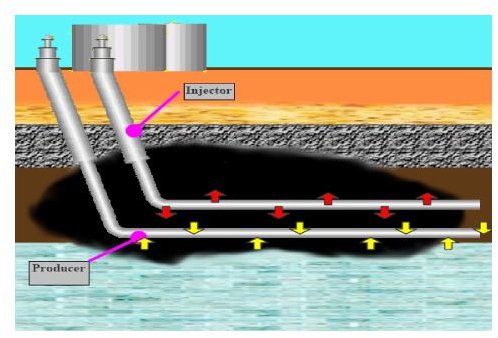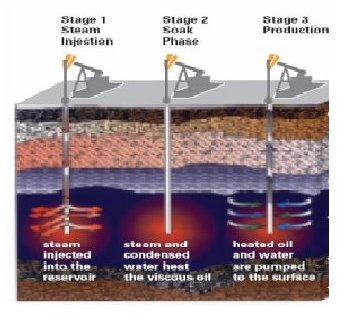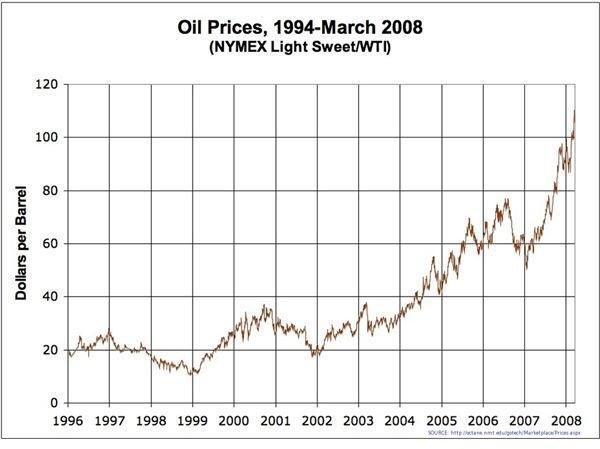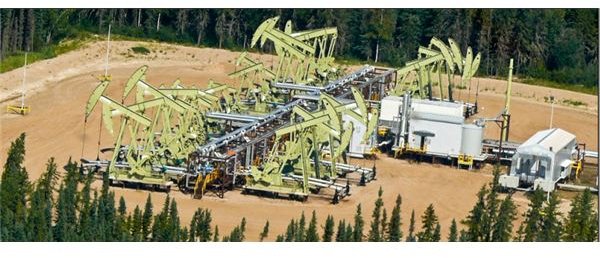Oil Sands Quest: The Search for Syncrude Oil from Oil Sands
Introduction to Oil Sands
This is an article on the extraction and processing of oil from unconventional oil sources, in this case oil sand. Here we will look at the world distribution of oil sand deposits and its composition, examining two methods currently employed in its extraction and production.
The production of oil from oilsands can be achieved by extracting the sands by open cast or in-situ mining methods.
The open pit method consists of removing the top layers of soil to expose the oil sands. This is then removed by bucket excavators and transported to the processing equipment.
In-situ methods include steam processing where horizontal injection and production wells are drilled into the sand deposits. Steam is injected into the horizontal injection well to liquefy the bitumen, enabling extraction via the production wells.
We begin then with a quick look at the world’s deposits of oil sands.
Major Oil Sands Deposits
In the quest for oil sands, numerous deposits of oil sand were found throughout the world; countries with oilsand deposits are listed below.
1. Canada
2. Venezuela
3. Russia
4. Brazil
5. USA
6. Portugal
7. Nigeria
8. Argentina
9. Cuba
Open Pit Mining and In-situ processing of Oil Sands
Oil sands are composed of about 80% sand, 6% clay, 4% water and 10% bitumen. They are found in 40-60 meter thick layers under a covering of peat, clay and sand.
Two methods are used to extract the sands and bitumen; open pit mining and in-situ processing.
- Open pit mining
This method is used if the sands can be exposed without having to remove too much of the top layers of peat and sand; in other words, if the layers of bitumen are near the surface.
Open pit mining for oilsands involves removing the topsoil and peat to expose the layer of oil sand. This is then scooped out using huge front-loading excavator trucks and transported to the process area.
- In-situ processing
This is used where the sands are too deep for extraction by the open pit method. The current method of in-situ processing is the use of steam as in Steam Assisted Gravity Drainage.(SAGD)
This consists of drilling twin horizontal wells near to the base of layer of oil sands, the top well being for injection and the other used as a production well. The top well is for steam injection, which when injected flows upwards heating the sands and making the bitumen less viscous. This allows it to flow downwards to the production well below from where it is pumped to the surface for further processing.
Processing of Oil Sands to Synthetic Crude Oil
The oil sand is transferred from the open pit by drawline or conveyors and fed into storage hoppers from where it is sent for crushing and screening.
Four stages are required to extract the oil from the sand.
1. Conditioning
There are two methods of conditioning. In the first method oil sands are fed into large steel tumbling drums where hot water is added and they are agitated to break away the bitumen from the sand to form slurry.
In the second, more modern method, known as hydrotransporting, the oil sands are made into slurry when they are fed into a large diameter steel pipe, into which hot water is injected, which makes slurry and keeps it moving forward at the same time. It is here within the pipe as it is transported towards the next stage that conditioning takes place, separating the bitumen, sand, clay, and water into individual layers.
2. Primary Separation
The slurry is now fed into the primary separation vessel where more hot water is added to encourage the separation. The froth containing bitumen rises to the top and is drawn off, meantime the sand sinks to the bottom leaving a solution of sand and bitumen suspended in the middle of the vessel. This is tapped off and pumped to the next process, the sand and water being drained from the bottom of the vessel and pumped to tailing ponds.
3. Secondary Separation
The middlings solution containing about 2% bitumen is now fed into flotation tanks where the majority of sand and clay is removed by flotation techniques. This causes the resultant bitumen froth to rise to the top of the tank where it is skimmed off.
As the bitumen froths still contains about 30% water and 10% sand and clays, it now passes through a de-aerator where steam is injected to remove any air along with the majority of sand and water.
4. Froth Treatment
To get it ready for its transformation into syncrude the bitumen is pumped to the froth treatment plant where naphtha or toluene is added to decrease its viscosity. It is then passed through inclined plate settlers. From here the solution is fed in to centrifuges where all remaining fine solids and water particles are removed. The oil is now ready for upgrading by a method such as thermal hydrocracking, converting it to synthetic crude oil and rendering it suitable for refining to petroleum products in the normal manner.
Economic Justification in Producing Syncrude From Oil Sands
Economic Justification
Currently the price of a barrel of crude oil is $83 and this makes the processing of oil sands very competitive. However in the 1980’s the price of a barrel of crude ranged from $15 to $38, and this lower price forced many oil sand operations to be suspended.
Oil experts say that when the price of crude is over $70 a barrel, the processing of oil sand is economically justified.
Production in Alberta, Canada
Alberta is producing 94 million barrels of sweet syncrude oil/ year
Images from the Internet Showing Oil Sands Processing (http://oilsands.infomine.com/commodities), Oil Price Chart (http//octane.nmt)




Environmental Impact
Both the extraction and processing of oil sands have a detrimental effect on the environment: from the activities in open pit mining where large overburdens are produced and from leaching from the tailing ponds. This is especially a problem to the indigenous people who use the land for agriculture and hunting for food.
Stricter environmental legislation from the Canadian Government has made these practices less damaging. However, there is still concern about the excessive usage of fresh water, along with the use of naphtha and toluene in the froth processing stage.
Internet Sites Visited
https://oilsands.infomine.com/commodities/
https://www.nationmaster.com/graph/ene_oil_res-energy-oil-reserves